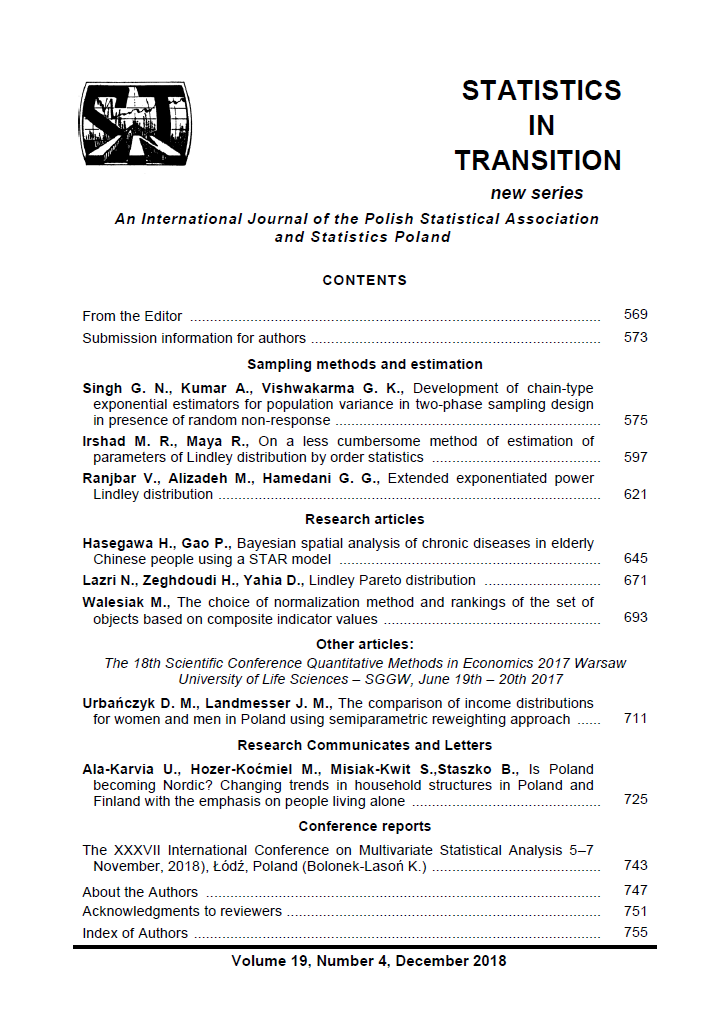ARTICLE
ABSTRACT
In this paper, we compare the income distributions for women and men in Poland. The gender wage gap can only be partially explained by different men’s and women’s characteristics. The unexplained part of the gap is usually attributed to the wage discrimination. The objective of the study is to extend the OaxacaBlinder decomposition procedure for the pay gap along the whole income distribution. To describe differences between two distributions of incomes we use a semiparametric reweighting approach (DiNardo, Fortin, Lemieux, 1996). The reweighting factor is computed for each observation by estimating a logit model for probabilities of belonging to men’s or women’s group. Then, we estimate probability density functions, including the counterfactual density function, using kernel density methods. This allows us to decompose the inequalities into the explained and unexplained components. The analysis is based on the EU-SILC data for Poland in 2014.
KEYWORDS
gender wage gap, differences in distributions, decomposition methods.
REFERENCES
BLINDER, A., (1973). Wage Discrimination: Reduced Form and Structural Estimates. Journal of Human Resources, 8, pp. 436–455.
DINARDO, J., FORTIN, N. M., LEMIEUX, T., (1996). Labor Market Institutions and the Distribution of Wages, 1973-1992: A Semiparametric Approach. Econometrica, 64, pp. 1001–1044.
DONALD, S. G., GREEN, D. A., PAARSCH, H. J., (2000). Differences in Wage Distributions between Canada and the United States: An Application of a Flexible Estimator of Distribution Functions in the Presence of Covariates. Review of Economic Studies, 67 (4), pp. 609–633.
EPANECHNIKOV, V. A., (1969). Non-parametric estimation of a multivariate probability density. Theory of Probability and its Applications, 14, pp. 153–158.
FIRPO, S., FORTIN, N. M., LEMIEUX, T., (2009). Unconditional Quantile Regressions. Econometrica, 77 (3), pp. 953–973.
FORTIN, N., LEMIEUX, T., FIRPO, S., (2010). Decomposition methods in economics. Cambridge: NBER Working Paper, No. 16045.
JUHN, CH., MURPHY, K. M., PIERCE, B., (1993). Wage Inequality and the Rise in Returns to Skill. Journal of Political Economy, 101, pp. 410–442.
KOMPA, K., WITKOWSKA, D., (2013). Application of Classification Trees to Analyze Income Distribution in Poland. Quantitative Methods in Economics, XIV (1), pp. 265–275.
LANDMESSER, J. M., KARPIO, K., ŁUKASIEWICZ, P., (2015). Decomposition of Differences Between Personal Incomes Distributions in Poland. Quantitative Methods in Economics, XVI (2), pp. 43–52.
LANDMESSER, J., (2016). Decomposition of Differences in Income Distributions Using Quantile Regression, Statistics in Transition - new series, Vol. 17, No. 2, pp. 331–348.
MACHADO, J. F., MATA, J., (2005). Counterfactual Decomposition of Changes in Wage Distributions Using Quantile Regression. Journal of Applied Econometrics, 20, pp. 445–465.
MATUSZEWSKA-JANICA, A., (2014). Wages Inequalities Between Men and Women: Eurostat Ses Metadata Analysis Applying Econometric Models. Quantitative Methods in Economics, XV (1), pp. 113–124.
NEWELL, A., SOCHA, M., (2005). The Distribution of Wages in Poland. IZA Discussion Paper, No. 1485, Bonn.
OAXACA, R., (1973). Male-Female Wage Differentials in Urban Labor Markets.International Economic Review, 14, pp. 693–709.
ROKICKA, M., RUZIK, A., (2010). The Gender Pay Gap in Informal Employment in Poland. CASE Network Studies and Analyses, No. 406, Warsaw.
SALARDI, P., (2012). Wage Disparities and Occupational Intensity by Gender and Race in Brazil: An Empirical Analysis using Quantile Decomposition Techniques. Brighton: University of Sussex, Job Market Paper.
SŁOCZYŃSKI, T., (2012). Wokół międzynarodowego zróżnicowania międzypłciowej luki płacowej. International Journal of Management and Economics, 34, pp. 169–185.
ŚLIWICKI, D., RYCZKOWSKI, M., (2014). Gender Pay Gap in the micro level –case of Poland. Quantitative Methods in Economics, XV (1), pp. 159–173.
WITKOWSKA, D., (2014). Determinants of Wages in Poland. Quantitative Methods in Economics, XV (1), pp. 192–208
